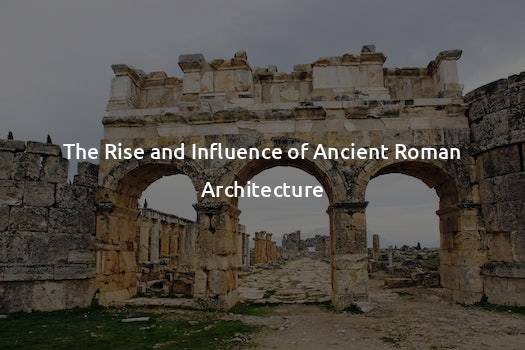The Rise and Influence of Ancient Roman Architecture
The Rise and Influence of Ancient Roman Architecture
Ancient Roman architecture has had a profound impact on the world, shaping the design principles and construction methods used in buildings even to this day. This architectural style emerged during the Roman Republic and reached its peak during the Roman Empire. From magnificent temples to grand amphitheaters, Roman architecture showcased a blend of functionality, grandeur, and innovation that still inspires architects and designers worldwide. In this article, we will explore the rise and influence of ancient Roman architecture.
Rise of Roman Architecture
The origins of Roman architecture can be traced back to the Etruscans, who heavily influenced early Roman builders. With the expansion of the Roman Republic and later the Roman Empire, the need for impressive public structures grew. Romans sought to create awe-inspiring buildings that symbolized their power, wealth, and commitment to their gods.
One of the earliest and most renowned examples of Roman architecture is the Colosseum, which stands as a testament to Rome’s engineering prowess and social hierarchy. Built in the first century AD, the Colosseum could accommodate up to 50,000 spectators and hosted various spectacles, including gladiatorial contests and mock naval battles.
Influence of Greek Architecture
While Roman architecture drew inspiration from various cultures, the Greeks had a significant influence on its development. The Romans admired and adopted many aspects of Greek architecture, such as column styles, proportions, and pediments.
The Roman architect Vitruvius played a crucial role in documenting architectural principles. His treatise, “De architectura,” discussed the importance of symmetry, durability, and functionality in building construction. This work, along with Greek architectural knowledge, formed a foundation for Roman architectural practices.
Architectural Elements
One key architectural element of Roman construction was the arch. Romans perfected the use of arches, which allowed the creation of larger and more stable structures, like aqueducts and bridges. The Pont du Gard in France is a remarkable example of a Roman aqueduct that utilized arches to transport water over vast distances.
Besides arches, the Romans also utilized concrete as a primary building material. They introduced a groundbreaking innovation by combining lime mortar, volcanic ash, and small stones to create a durable and versatile material. This advancement in construction techniques enabled the Romans to erect structures quickly and efficiently, transforming the architectural landscape.
Types of Roman Buildings
Roman architecture encompassed various building types, each serving a specific purpose. Temples were created as places of worship and demonstrated Roman religious convictions. The Pantheon, another iconic Roman structure, is a remarkable temple that showcases the grandeur of Roman design. Its dome is one of the largest unreinforced concrete domes in the world, a testament to Roman architectural prowess. The Pantheon served as a place of worship for multiple deities and later became a Christian church.
Roman amphitheaters, such as the Colosseum, were constructed for entertainment purposes. These massive structures hosted gladiatorial contests, chariot races, and other public spectacles, reflecting the social and cultural significance of such events.
The Romans also developed impressive civic buildings, such as basilicas, which served as public meeting spaces and centers of civic administration. Additionally, they constructed triumphal arches to commemorate military victories and serve as symbols of Roman supremacy.
Enduring Legacy
Despite the fall of the Roman Empire, ancient Roman architecture has left an indelible mark on the world. The architectural principles and techniques pioneered by the Romans continue to inspire architects and shape modern building design.
Today, numerous buildings around the world draw inspiration from Roman architecture. For instance, government buildings and courthouses often feature neoclassical architecture, with grand facades, columns, and porticos reminiscent of ancient Rome. The United States Capitol building in Washington, D.C., and St. Peter’s Basilica in Vatican City are prominent examples of this influence.
The enduring legacy of ancient Roman architecture can also be seen in residential architecture, where elements such as arches, columns, and domes continue to be popular design features.
TLDR;
Ancient Roman architecture emerged during the Roman Republic and Empire, blending functional design with grandeur. Influenced by the Greeks, Romans perfected the use of arches and concrete, allowing for the construction of remarkable structures like the Colosseum and the Pantheon. The architectural principles and techniques developed by the Romans continue to inspire modern designs and can be seen in buildings worldwide.







